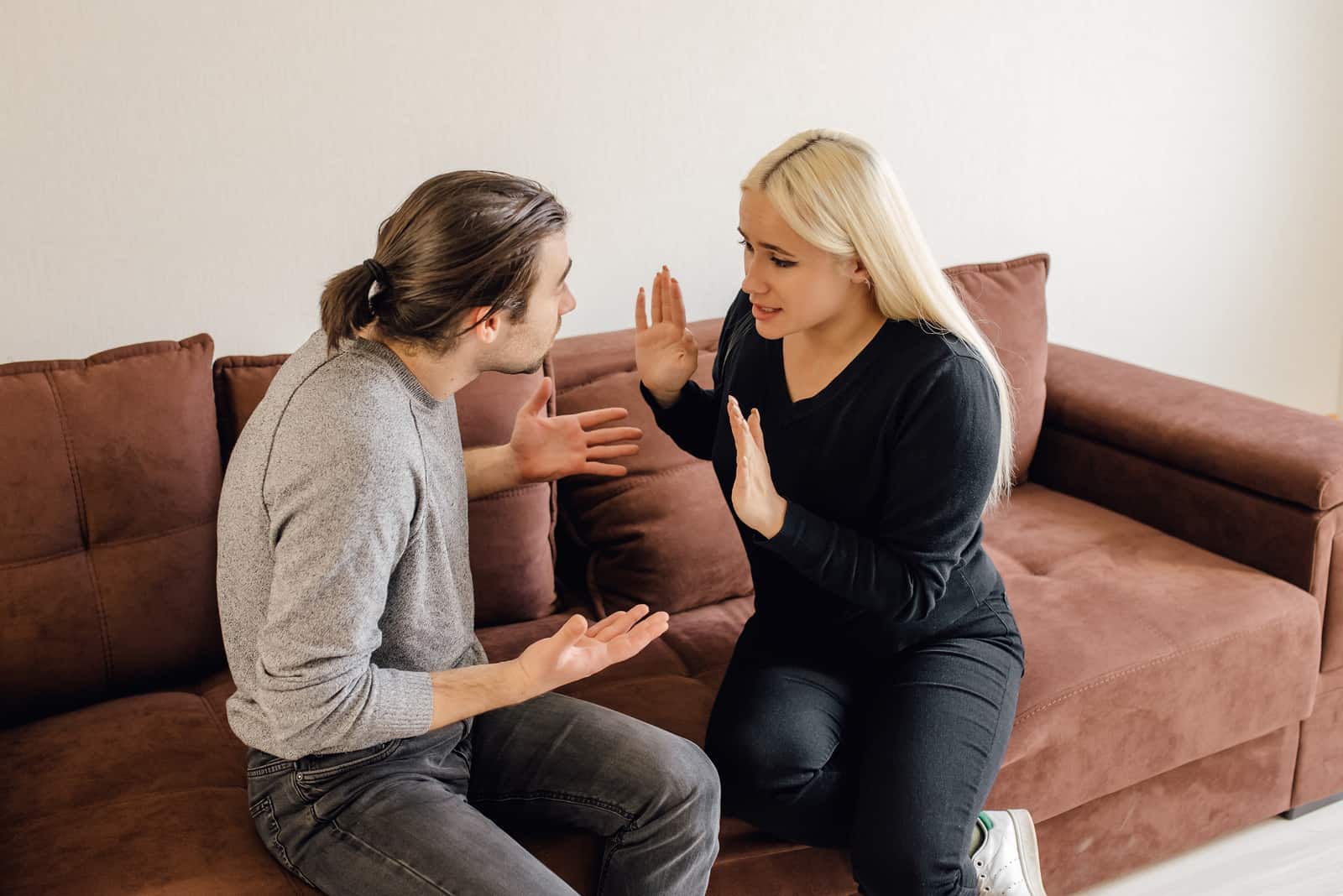I saw my friend’s boyfriend with another woman a while back. I was shocked and convinced that he was cheating on her.
After I weighed all the pros and cons of telling her everything, I decided to get it off my chest. But she wasn’t the shocked one here.
It’s not just that she didn’t mind him kissing another girl in public – she was perfectly aware of what was going on.
Actually, she told me that they have been in a successful open relationship for a while now. So naturally, I wanted to know all about it.
At first, she told me to read the book The Ethical Slut: A Guide to Infinite Sexual Possibilities published back in 1997, and so I did. And yes, I’ve obviously heard about non-monogamous relationships before (it’s not like I’m living under a rock), but I was eager to find out everything first-hand.
How does it work? What are the ground rules? Is it possible for a long-term relationship to be non-monogamous? What about jealousy?
Luckily for me, she was quite patient. She responded to all of my questions and was generous enough to give me all the information I needed. Here are all the secrets of non-monogamy revealed:
Being In An Open Relationship – Meaning
What is an open relationship? Is it cheating? Does it mean that you’re keeping your options open?Well, according to the simplest open relationship definition, it’s a romantic relationship that is not monogamous.
Basically, both partners are permitted to have sexual relationships or date other people outside of their primary relationship. It is quite the opposite of a monogamous relationship where two people date each other exclusively.
It’s important to differentiate consensual non-monogamy from being unfaithful. In this case, intimacy with other people is not cheating because it happens with the permission of the primary partner and not behind their back.
Open Relationship Types
Let’s make one thing clear as well: there are numerous different types of relationships that might fall under the umbrella term of open relationship. Here are the most common:
• Polygamy
Polygamy means that you’re married to more than one person at the same time. There are the two most common forms of polygamy: polygyny (more wives married to one husband) and polyandry (more husbands share one wife).
• Swingers
Swinging is an activity that includes partner-swapping during sex. It is usually performed in between numerous couples who engage in group sex or just exchange their partners.• Polyfidelity
When you practice polyfidelity, you’re completely faithful to all the people you’re in a relationship with, and there is no fooling around outside your romance(s).
It’s also non-monogamous because it includes a group of people (three or more), but it’s different from an open relationship because it forbids any kind of sexual or emotional connection outside the primary relationship(s).
• Monogamish
Monogamish relationships differentiate between emotional and sexual fidelity. Basically, there is emotional exclusivity, but both partners are allowed to have meaningless sex with other people – as long as they don’t develop feelings.
Open Relationship Rules
Every romantic relationship must have some rules – what’s okay and what’s not acceptable under any terms.But this is even more significant in an open relationship. Both you and your partner have to agree on things you’re ready to tolerate – that is, if you don’t want to turn this into one big mess that is doomed to fail.
Even though every couple is a story for themselves, here are some of the crucial rules for making this type of relationship work.
Consent
Let’s start with the most obvious and, at the same time, most important ground rule: both parties have to be 100% sure that this is what they want. Don’t worry – nobody will think that you’re a prude for not being okay with this type of relationship.
Some people are perfectly happy with being monogamous, and that’s something they should always be clear about. So, if your romantic partner suggests an open relationship or being in a half-open marriage, and you don’t think it’s something you could handle – please, be honest about it.
If there is no mutual consent, then it’s basically cheating. There is no point in being in this kind of relationship if one person is suffering because of it.
Sexual boundaries
Consensual non-monogamy can’t be possible without both partners setting some basic boundaries regarding their sexual activities with other people. What is acceptable and what is not?Of course, you have to start with the premise that you’ll both be completely honest and stick to the deal. So if you and your partner agree that there is no, let’s say, bringing other people into your bed, doing exactly that, and remaining quiet about it is not cool.
Some couples agree that kissing, cuddling, or oral sex are off the table. On the other hand, some don’t allow penetration to happen at all.
This all depends on what you and your partner want and can handle. What’s crucial here is to talk things through in detail before engaging in any sex practices with other people.
Safe sex
When you have an active sex life (especially this active), safe sex is a must. This is also something that has to be discussed before engaging in any activities outside of your relationship.
Remember – you’re not responsible only for your health here – you’re also responsible for your partner’s.
The first thing you need to agree on is protection. Some people use a condom every time they sleep with a third person, while some go a step further and request everyone included in this relationship to be tested for sexually transmitted infection.
You might think that this is too much, but if you dig a little deeper, you’ll see that the risk of STI is real, especially when you have multiple sexual partners. Either way, always put safety first, even before your sexual needs.
Time boundaries
One of the rules for open relationships is also about time boundaries. It’s important to set up the amount of time you’ll both spend with your new partners as well as the amount of time you’ll spend with each other.
Keep in mind that your primary partner should always come first. Therefore, you shouldn’t, by any means, neglect them just because you like someone else more at one point.
That’s why it is good to agree on regular check-ins with your primary SO. Even if you go on a trip with someone else (if that is allowed), text or talk to your partner and agree about the frequency of these check-ins.
I warn you: these things will happen. You meet a new partner, and everything around them becomes exciting.
You want to discover all parts of their personality, and you would spend most of your time with them rather than go back home where everything is familiar and comfortable. This doesn’t mean you don’t love your primary romantic partner – it’s just a sign that you’re a human being.
Nevertheless, if this is an urge you’re unable to control, maybe you should reconsider your decision of being in an open relationship. Remember that your new relationship can never endanger your primary romantic relationship.
Emotional boundaries
The same goes for emotional boundaries. It might sound silly for someone to tell you if you’re allowed to fall in love with another person or not.In most cases, this is something you can’t control as much as you might like to – at least, most people don’t have that ability. These guidelines are much harder to determine in contrast to sexual or time ones.
How can you decide that you’ll like someone else but won’t fall in love? Where is this imaginary boundary?
Do you call it quits the first time you feel butterflies? Are you emotionally mature enough to admit to yourself (and your partner) that your feelings are about to cross the line?
This is quite impossible. That’s exactly why many couples decide whether it’s okay to have casual hookups (and how many times is one allowed to see this third person before it turns into some kind of a relationship) but put a veto on actual dating.
Again, the choice is all yours. The two of you are allowed to set up your relationship dynamic according to your emotional and sexual needs.
Privacy
Most couples adopt something called the “don’t ask, don’t tell” policy. This means that they keep their out-of-relationship activities to themselves.
On the other hand, some choose to keep their partner up to date on who they’re seeing (and how often it happens). Many couples prefer this option because they feel like they have more control over what their SO is doing.
Nevertheless, we’re talking about basic info here only. There are no juicy details that might potentially bother the other person.
Then there is the third option where you tell you SO literally everything. Some couples find this sexually arousing and emotionally bonding.
Let me tell you something: if you’re in the beginning of your open relationship, you won’t know what alternative suits you the best. You’ll probably have to try all of them and see which one works for you.
Relationship style
You can’t have a successful open relationship until you decide which relationship style you prefer. Will it be a polyamorous relationship?Will you only have sexual relationships outside of your current relationship? Are you allowed to have multiple sexual partners at a time?
Will you be swingers without any emotional attachment involved?
Time frame
After you study all of these types of relationships and agree on the one which suits you the best, you should also discuss the time frame.
Is this something you are both willing to just try out? Or is it a lifestyle you’re planning to pursue?
If you plan on tying the knot, will you have an open marriage? Or will you experiment until you say your vows?
I know that this is probably a lot to handle right now, and nobody is expecting you to have all the answers right away. Actually, I’m just trying to fill you in on every doubt and issue that will probably crop up throughout your journey.
Open communication
Communication is the key to every healthy relationship – no matter which romantic relationship we’re talking about. Nevertheless, open communication is especially important for open relationships.
Both you and your partner have to be 100% honest about your feelings, expectations, wishes, and demands. You have to be able to communicate everything you want and don’t want and be especially clear about your deal-breakers.
Trust me – nothing will work out if you play toxic mind games. Also, you must avoid guessing, assuming, and mind-reading.
Your SO can’t possibly know how you feel unless you speak out, and it goes both ways.
Don’t jump to conclusions. Instead, always be straight with your SO, and you can expect the best.
Honesty with the third person
Even though your current relationship is your number one priority, the last thing you want is to break some hearts along the way while you’re trying to achieve emotional or sexual satisfaction.What does this mean? Well, you must be 100% honest with whoever you get involved in your open relationship.
Of course, your opening line doesn’t have to be a speech about your situation. Nevertheless, the moment you see that the flirting is crossing the line and that something more might happen, you have to tell them everything that’s going on.
All the people included in this situation have the right to know all the rules and circumstances. Otherwise, all hell might break loose, and I don’t even have to start about all the potential consequences.
Yes, you’ll meet some people who are perfectly okay with the current setup. They’ll be content with the fact that your SO is familiar with everything and that you’re not cheating. Nothing else will bother them much.
But beware that some people are only into monogamy and are looking for a committed relationship. In that case, move on and look for someone else who’ll be willing to participate in your adventures.
The right reasons
You have to ask yourself: Why am I getting into this kind of a relationship? You see, if you do it for the wrong reasons, you can’t expect anything good to come out of it, can you?
Is it because you miss sexual activities with other people? Is it because you want to spice things up back at home?
Is it because you and your partner have different libido levels? Is it because you want to explore your sexuality and improve your sex life?
Or is it because you feel like you are perfectly capable of loving other people without it endangering your relationship?
Is it because you think that monogamy is nothing but a social concept that doesn’t suit your relationship, or maybe you consider it unnatural?
These are all the most common reasons people engage in consensual non-monogamy. And nobody can argue against any of them.
But if you’re engaging in non-monogamy because you want to save your relationship that’s doomed to fail, make your partner jealous, or because you stopped loving them (or are no longer attracted to them), it probably won’t work out.
Feelings of jealousy
Finally, the question all monogamists ask: How do you avoid being jealous in a non-monogamous relationship?Look, you’re human. It’s natural that you’ll struggle with feelings of jealousy.
Nevertheless, we’re not all the same. If this is something you can fight off, open relationships are right for you.
On the other hand, if your jealousy starts to overwhelm you and begins to impact your relationship, it’s a red flag that this isn’t for you.
How to fight it?
The first step in dealing with jealousy is acknowledging it. Accept it as something completely normal, and don’t accuse yourself of not being good at this right away.
After that, be honest with your partner about your feelings. Remember: open communication is the key.
The next step is to do your best to examine your jealousy. Why do you feel like this? Try to analyze it and find the root cause.
Do you feel endangered by someone else in your SO’s life? Do you feel emotionally neglected?
Talk things through and maybe set some new boundaries. If you’re not okay with only a few aspects of your partner’s activities, talk about the rules once again, and if necessary, change them.
Polyamory Vs. Open Relationship
So, both open and polyamorous relationships are non-monogamous relationships and include being with more than one person at a time. If you haven’t dug too much into the matter, you might assume that these two words are synonyms that mean practically the same thing.Nevertheless, they are two different relationship styles. There are some differences between polyamory and an open marriage or relationship, and here are the most important ones:
Sexual satisfaction vs. emotional connection
The first and the most important difference between an open relationship and a polyamory one is in the primary thing you’re looking to get out of this situation. In most cases, couples in open relationships are looking for sexual satisfaction only.
It means that these out-of-relationship activities are mostly based on random hookups (that sometimes grow to be more than that) and meaningless sex. On the other hand, polyamory includes emotional bonds with other people besides your partner.
You’re not just sleeping with other people – you’re also in relationships with these people. You date them, see them in different social contexts, and eventually fall in love with them.
Of course, it all happens with your first partner knowing and being okay with it. In fact, they’re doing the same thing.
Everyone included knows what’s going on, and nobody is bothered by the situation.
No relationship hierarchy
Another crucial contrast is that there is no relationship hierarchy. It means that there is no primary partner and primary relationship – everyone is equal.If you have two (or more) separate relationships, you treat both of your GFs or BFs pretty much the same. None of them is a sexual fling – they’re both your romantic partners.
You do your best to give them the same amount of love, attention, gifts, and so on.
On the other hand, if there are multiple people all in one relationship, they’re all equal parts of it.
In that case, you’re expected to be faithful to all the people in the relationship, and if you do something outside of it, it’s considered cheating.
Let’s put it this way: if a man has two wives, he’s a polygamist. But in this scenario, these two wives are not in a relationship with each other – they’re just co-wives who share the same husband.
How is polyamory different? Well, if we have three people involved, all three of them are in a relationship with each other. If a man has two GFs, they’re also in a relationship with one another, and each of them is in a relationship with the guy.
Open Relationship Celebrities
You’d be surprised by the fact that open relationships are actually more common than you might think – especially among famous people. Hollywood is full of non-monogamous couples, and here are the most famous ones:- Megan Fox and Brian Austin Green
- Nico Tortorella and Bethany C. Meyers
- Gwyneth Paltrow and Chris Martin
- Will Smith and Jada Pinkett Smith
- Tom Ford and Richard Buckley
- Demi Moore and Bruce Wills
- Tilda Swinton and John Byrne
- Angelina Jolie and Brad Pitt
Does An Open Relationship Work?
At the end of the day, nobody can give you the answer to this question because every case is unique. An open relationship definitely can work (after all, there are tons of examples to prove my point) under some conditions, and most of them are mentioned above.Nevertheless, it all depends on your preferences. Nobody can tell you that this is the right or the wrong way to live your life.
If it works for you, and you and your partner aren’t harming anyone in the process – go for it, and forget about what other people say or think.
Media: https://www.youtube.com/watch?v=rH2td_9ckUA













